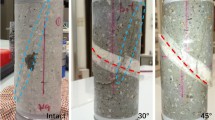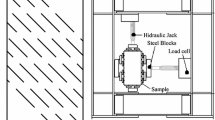Summary
Numerical Analyses of Deformability Tests in Jointed Rock — “Joint Perturbation” and “No Tension” Finite Element Solutions
Sound design of structures in or upon rock requires a thorough knowledge of the rock mass deformability. Field test data interpretation has generally relied upon analytical or Finite Element linear elastic solutions. However, when testing in jointed rock, these can no longer be readily used since the medium cannot resist the tension induced upon loading. Accordingly, other solutions are required. If the discontinuities of the rock mass can all be mapped and their surface properties determined, the Finite Element model will use a “Joint Perturbation” solution where the “joint” elements have variable stiffnesses to account for movements along the fractures. If the discontinuities cannot be satisfactorily mapped, a global approach is provided by a “No Tension” analysis of the “stress transfer” type. The two techniques are compared in the case of bore hole jack deformability tests and found to agree remarkably well, indicating an appreciable difference from results of linear elasticity.
Zusammenfassung
Numerische Analyse von Verformungsversuchen in geklüfteten Fels — Lösungen mittels „Kluft-Perturbation“ und „No Tension Analysis“ auf Grund der Methode der Finiten Elemente
Der Entwurf von Bauwerken in oder auf Fels erfordert eine genaue Kenntnis des Formänderungsverhaltens der Felsmasse. Im allgemeinen basiert die Interpretation der Ergebnisse von Feldversuchen auf den Lösungen des zugehörigen Randwertproblems der linearen Elastostatik mittels klassischer analytischer Methoden oder der Methode der Finiten Elemente. Wenn die Versuche aber in geklüftetem Fels durchgeführt werden, müssen die theoretischen Methoden modifiziert werden, da das Medium keine Zugspannungen aufnehmen kann. Zwei Fälle können unterschieden werden. Erstens: die Kluftflächen der Felsmasse können geometrisch erfaßt und ihre Oberflächeneigenschaften können bestimmt werden; in diesem Falle kann die Finite-Elemente-Lösung eine „Kluft-Perturbations“-Methode verwenden, in welcher spezielle „Kluft“-Elemente verschiedener Steifigkeiten normal und tangential zu den Kluftflächen die Bewegungen entlang derselben bestimmen. Zweitens: die Diskontinuitäten der Felsmasse können nicht hinreichend beschrieben werden; für diesen Fall ist vorgekehrt durch die Finite-Element-Analyse vom Typ der „Spannungsumlagerung“ unter Ausschaltung der Zugspannungen („No Tension Analysis“), um das globale Verhalten der geklüfteten Felsmasse zu erfassen. Die Lösungen dieser beiden Methoden wurden für den Fall der Bohrloch-Verformungs-Tests verglichen; der Vergleich zeigt ausgezeichnete Übereinstimmung, im Gegensatz zu den Lösungen als lineares Elastizitätsproblem.
Résumé
La méthode des Eléments Finis appliquée aux résultats d'essais de vérins cylindriques dans les roches fissurées — solutions dites “Joint Pertubé” et “Sans Traction”
La construction de structures sur ou dans des roches nécessite une connaissance approfendie de la déformabilité du massif rocheux. L'analyse des résultats d'essais en place se fait généralement à l'aide de solutions analytiques ou par Eléments Finis, qui supposent une élasticité linéaire du milieu. De fait, dans les roches fissurées, ces solutions sont inadéquates puisque le milieu ne peut résister aux sollicitations de traction. Il s'agit donc d'utiliser d'autres méthodes d'analyse. Lors qu'il est possible de déterminer la géométrie et les propriétés de toutes les discontinuités, l'on pourra utiliser une solution par Eléments Finis, dite “Joint Perturbé” dans laquelle la rigidité de surface du joint (ou fissure) peut varier lorsque des movements prennent place au niveau du joint. Si cela est impossible, il faudra utiliser une approche globale dite “Sans Traction” qui redistribue les contraintes de traction et les dissipe. On compare ces deux types de solutions dans le cas des essais de vérins cylindriques unidirectionnels. Leurs résultats sont identiques et ont nettement différents de ceux obtenus avec une solution élastique linéaire.
Similar content being viewed by others
References
Doherty, W. P., E. L. Wilson, and R. L. Taylor (1969): Stress Analysis of Axisymmetric Solids Utilizing Higher Order Quadrilateral Finite Elements. Rep. No. 69-3 Structural Eng. Lab., University of California, Berkeley, January.
Goodman, R. E., T. K. Van, and F. E. Heuzé (1968): The Measurement of Rock Deformability in Bore Holes Proc. 10th Symp. on Rock Mechanics, Austin, Texas, May.
Goodman, R. E., R. L. Taylor and T. Brekke (1968). A Model for the Mechanics of Jointed Rock. J. Soil Mech. and Found. Div. Proc. ASCE v. 94 n. SM 3.
Heuzé, F. (1967): Mechanical Properties and In Situ Behavior of the Chino Limestone, Riverside, California. M. Sc. Thesis, University of California, Berkeley, March, also (R. E. Goodman co-author) Proc. 9th Symp. on Rock Mechanics Golden, Colorado, April.
Heuzé, F. (1970): The Design of Room and Pillar Structures in Competent Jointed Rock. Example: The Crestmore Mine, California. Doctor of Engineering Dissertation, Dept. of Civ. Eng. University of California, Berkeley. Also (R. E. Goodman co-author) Proc. 2nd Congress ISRM, Belgrad, Yugoslavia, vol. 2, Themc 4.
Stagg, K. G., and O. C. Zienkiewicz (1968): Rock Mechanics in Engineering Practice. J. Wiley & Sons Ed.
Van, T. K. (1967): In Situ Determination of Rock Deformability by Bore Hole Jack Tests. Unpublished M. Sc. Thesis, Dept. of Civ. Eng. University of California, Berkeley, December.
Wilson, E. L. (1963): Finite Element Analysis of two Dimensional Structures. Doctor of Engineering Dissertation, University of California, Berkeley, June.
Wilson, E. L. (1965): Structural Analysis of Axisymmetrie Solids. AIAA Journal v. 3.
Zienkiewicz, O. C., S. Valliappan, and I. P. King (1968): Stress Analysis of Rock as a “No Tension” Material. Geotechnique v. 18 n. 1.
Zienkiewicz, O. C., S. Valliappan, and I. P. King (1969): Elasto Plastic Solutions of Engineering Problems “Initial Stress”, Finite Element Approach. Int. Journ. for Numeric. Meth. in Engineering v. 1.
Author information
Authors and Affiliations
Additional information
Research supported by the National Aeronautics and Space Administration — Contract NAS 8-21432.
With 8 Figures
Rights and permissions
About this article
Cite this article
Heuzé, F.E., Goodman, R.E. & Bornstein, A. Numerical analyses of deformability tests in jointed rock — “Joint Perturbation” and “No Tension” Finite Element solutions. Rock Mechanics 3, 13–24 (1971). https://doi.org/10.1007/BF01243549
Received:
Issue Date:
DOI: https://doi.org/10.1007/BF01243549




